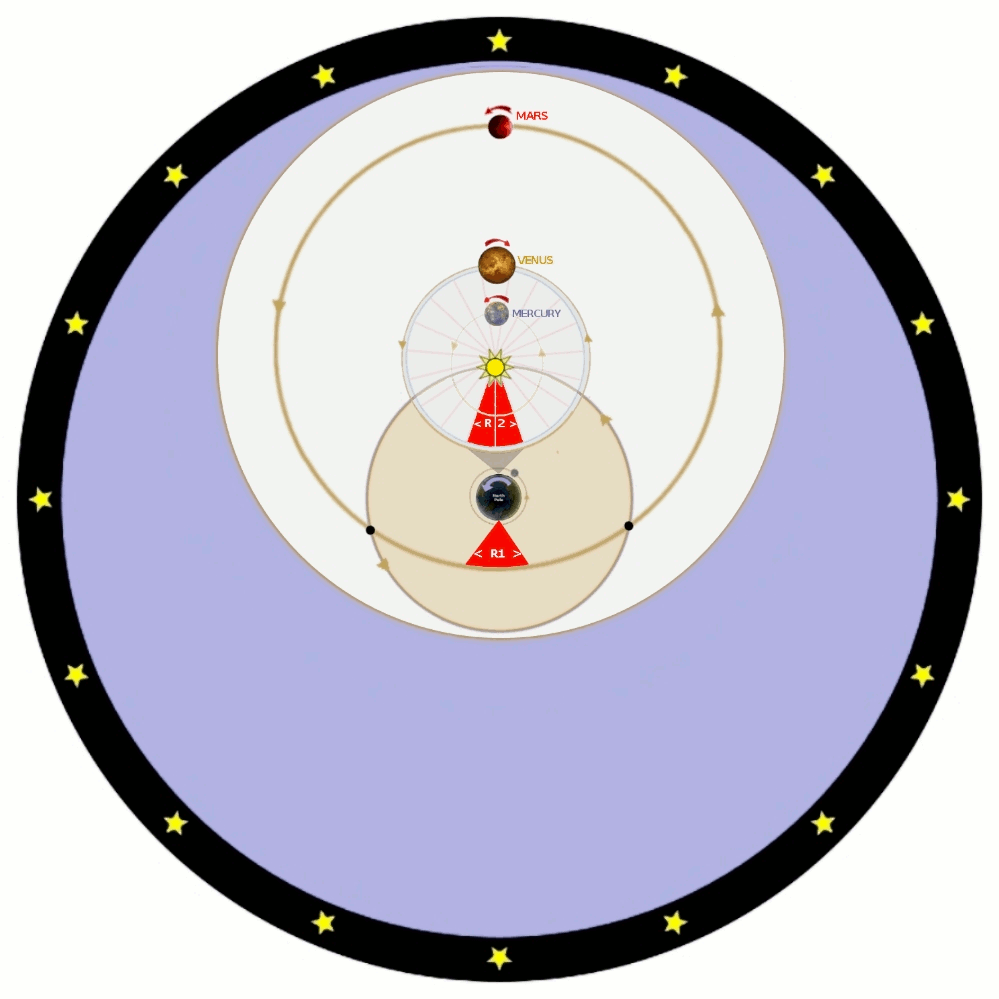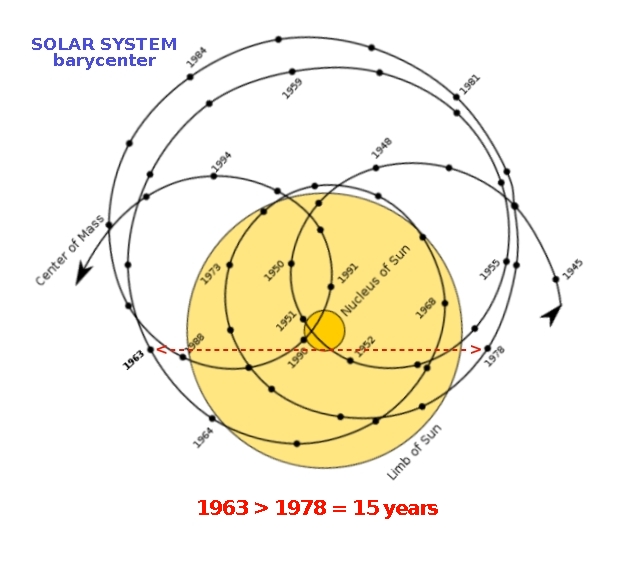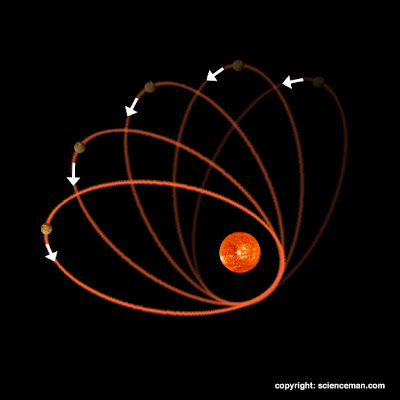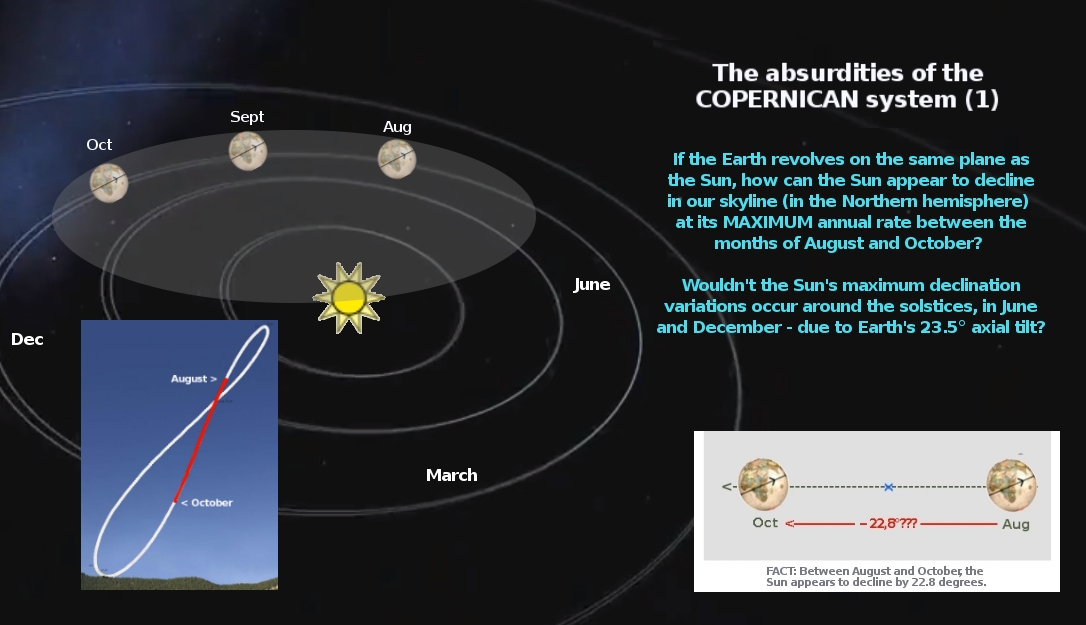hoi.polloi wrote:
Though I have tried to follow your latest Mars diagrams, I wasn't quite getting how the 780 day period (or 788 average/mean?) fit into the sidereal orbits, so I snagged Mars' purported sidereal orbit period of 686.98 "days" (I assumed they meant Mars sidereal days which are 1.029 the length of Earth sidereal days, but it turns out they are rather stupidly using Earth solar days) so actually that would mean it takes Mars 686.98 (Earth days) times 1.0027366354007812989617497754288 (ratio of Earth sidereal days within Earth solar days) to reach the number of "sidereal Earth days" for Mars to return to the same "star longitude" (drawn from the Sun to Mars, as measured by the star field).
That number is roughly 688.86.
Hoi,
I fully understand your puzzlement regarding Mars - and its sideral / synodic periods. I will get to this thorny, grey area in a minute - but let me first propose a few amendments to your submitted sidereal period figures. See, the problem with the planet's sidereal period figures (as opposed to the synodic periods which we can precisely observe from Earth) is that they are all approximated calculations as to what we would see/record
if we were actually standing on these planets. This is of course not possible and, as you will see, there is a very special problem regarding Mars which, due to its more complex, more-than-one-year-long orbit around Earth - has had all the greatest (European) minds baffled for centuries(yet the ancient Maya people knew better!)
Sun's orbit: 36
5.242 ESD (Earth Sidereal Days)
Earth's annual rotations: 36
6.242
This is most important - since we're saying that the Sun (our "OUTER" as opposed to inner 'planet') circles Earth, therefore the one revolution that the Sun makes yearly around Earth will substract one day from the 366 times that we see any given star annually.
Moon's orbit: 27.32166 ESD
(Note: the synodic lunar period is 29.5 days - precisely one day less than the 30.5 average of our earthly months [ 30.5 X 12 = 366 ] - since the Moon is also one of our "OUTER planets").
Mercury's orbit: 87.97 ESD
Venus' orbit: 224.7 ESD
Mars' orbit (ESD) :
> well, this is an entirely different matter. Please read on.
************
MARS - the KEY?
It was the great Kepler - not little me - who said that Mars is the key to the understanding of our universe :
"It is of great importance to note that by late 1602, Kepler already saw the work on MARS as the "key to universal astronomy".
http://books.google.it/books?id=_NZsb6B ... se&f=false
Before I submit and expound my personal, humble take on Mars's cyclic motions in our skies, let me firstly highlight how much Mars meant to Kepler - and how fundamental his work on Mars's motions (using/& abusing Tycho Brahe's empirical observations) was to be in his path to universal fame as the 'Giant of Astronomy' which he's still considered to this day. Here are some extracts from
"The Composition of Astronomia Nova" - a book by James Voelkel (linked above) which should give you a sense of the central importance that Mars had to Kepler - ultimately leading to his famous three "laws of planetary motion" and indeed, ultimately leading to the formulation of Newton's even more famous and world-defining
"Laws Of Universal Gravitation".
There is no question, of course, that these two men - Kepler and Newton - have been instrumental in defining our universe as we know it - and that questioning / reviewing their work is among the most daunting activities any individual may embark upon today. However, dear reader, all I'm doing here is to submit the results of my personal efforts to help myself understand some intriguing aspects of our universe - and sharing them with you. But let's see now how much exhausting head-scratching that pesky Mars planet caused to Kepler...
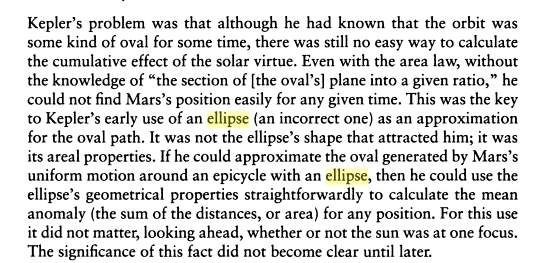
and further ...
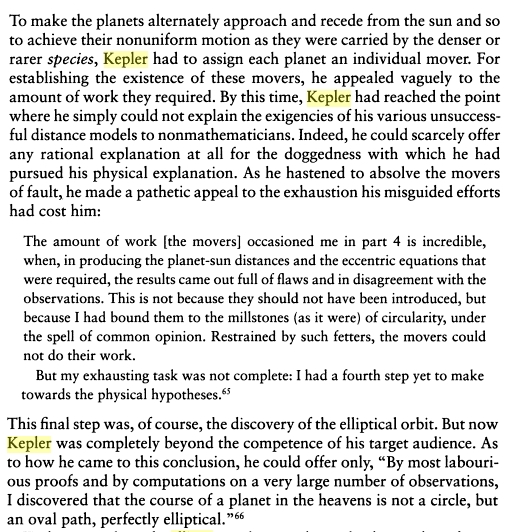 "An oval path? Perfectly elliptical" ??
"An oval path? Perfectly elliptical" ?? See, here's my problem with this elliptical/eccentricity business - and I hope you will carefully consider my following points and (linear) line of reasoning : how on Earth could Kepler, back in the telescope-less 16th century (and with all respect for Tycho Brahe's observational skills) - possibly have detected any sort of non-circular, ellipsoidal motion of ANY planet? This, if Mars is - as we are told - a planet which simply circles around us in a ring, with a minuscule eccentricity (as modern astronomical data has it) of 0,093? To be sure, ALL planets -
as listed today - have almost perfectly circular orbits with laughably small / barely detectable ellipsoidal shapes in the range of 0,0-something (Earth>0,0167 - Venus>0,006 - Jupiter>0,048 - Saturn> 0,054 - Uranus> 0,047 - Neptune> 0,008) - with the exception of Mercury, "the crazy planet", whose orbit still isn't more than 0,2 of an ellipse. So what exactly brought Kepler to even consider the elliptic orbit hypothesis in the first place? Did perhaps something in Tycho's observational data suggest it? If so, what? Kepler certainly didn't have much to work on - other than Tycho's annotations of his observations of the night skies, let this be clear!
So let us take a look again at Tycho's solar system model. Try imagining - just imagining - the entire white disk in the below diagram starting to rotate around the Earth's axis, with Mars proceeding at a slower rate than the disk itself. I know, it is a pretty tough mind exercice - but maybe some of you will remember the old Spirograph drawing set?

Now, the problem is that Mars (in Tycho's model - and, I believe, in reality!) completes its own orbit around Earth in about 2years and 2 months - or 2,135 revolutions or -
APPROX 780 days. This makes it extra difficult to illustrate Mars's motion in a graphic - and even more so, for any astronomer to observe and understand it from the 'horizontal', co-planar point of view in which we are ALL restricted to view our surrounding planets - from our earthly perspective! If we could look down from the North Star, it would all be a lot easier... The thing is, we would have to stay up there for 15 years - in order to see the full cycle of Mars.
THE 15-YEAR MARS CYCLE
The patient, ancient Maya people evidently had more time on their hands - and were fully aware of the full Mars cycle, which is what one really needs to visualize in order to understand how Mars moves about in the skies. Here is a fascinating article discussing exactly why the Maya knew that each of Mars's seven synodic cycles lasts for 780 days - whereas modern astronomy is still stuck with Kepler's 'inobservable' 686-day cycle :
Ancient Maya documents concerning the movements of Mars http://www.pnas.org/content/98/4/2107.full.pdf
Concern with the sidereal cycle of Mars
"For Mars, this period is timed by modern astronomy at 686.98 days, and it is not directly observable. However, a sidereal period, in the sense that it is a cycle that tracks the movement of a planet relative to the stars, that is directly observable would measure the interval between two successive passages of a planet by a given longitude."
(This pdf article is obligatory reading if you wish to comment on the present post.)
Fortunately, there are also modern researchers who keep compiling observational data of the long-term motions of Mars. I was lucky enough to find
this fine diagram (yes, on Wickedpedia!), which depicts a full 15-year Mars cycle. Better still, the diagram duly mentions that it is "Earth-centered", i.e. it is to be interpreted from a geocentric frame of reference:
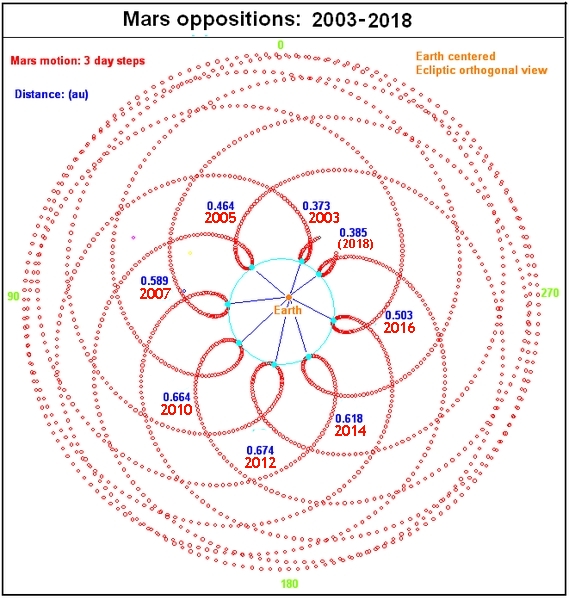 CHART OF MARS OPPOSITIONS DATES: http://cseligman.com/text/planets/marsoppositions.htm
CHART OF MARS OPPOSITIONS DATES: http://cseligman.com/text/planets/marsoppositions.htm
The "Mars oppositions" are the moments in time when Mars is closest to Earth - and lined up with the Sun (at the opposed side of Earth). It is also the time when we see Mars 'retrograding' for about 2 months or so - and also the time when Mars reaches its lowest point of its orbit - which is tilted by about 1.5degrees vis-à-vis Earth's orbit.
So I made a few mental, deductive and geometrical calculations - and came up with this diagram (pardon my poor Spyrographic skills - my MARS path is meant to show perfect circles, moving forward in time. As the circles intersect, they create the illusion of MARS's "elliptical" motion - to an earthbound observer!):
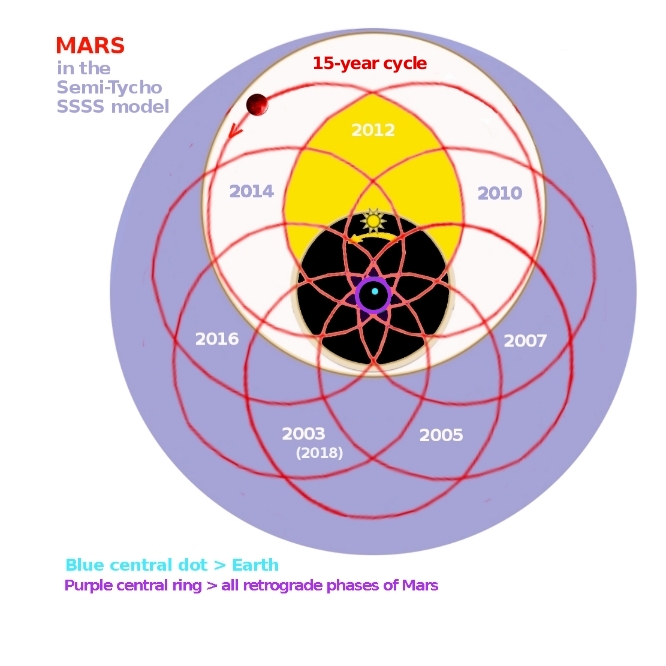
As you can see, Mars's orbit would actually be tracing BOTH
circles AND very much 'ovoid'
ellipses - a bit like a rose pattern (as described by
Klemperer)- and lo and behold ! -
there is that oval shape that Kepler so desperately tried to wrap his head around ! THE OVAL IS SIMPLY THE NATURAL RESULT OF A HELICAL / PRECESSING CIRCULAR MOTION!
"The whole of 1604 and the beginning of 1605 were devoted to working out the theory of the 'oval', and comparing it with observational data".
http://books.google.it/books?id=dAzVuXq ... on&f=false
My diagram is obviously not to scale, but please know that Mars (as modern astronomy tells us) can be as far as 400million km from and as close as 55million to Earth. As Mars is in opposition it makes a "u-turn" in close proximity to Earth, which may go to explain its "retrograde motion" as we can observe every 780 days or so (On August 27, 2003 - apparently - Mars was as close as it hadn't been since 60.000 years).
The standard explanation for Mars's "retrograde motion" is not much different from my own. Yes, it has to do with perspective - but also with time. As Mars closes up to our rotating Earth, we watch it from our time/space perspective (we measure our Earth's rotation with our clocks) - and Mars will appear to 'stop & reverse' its path against the star background for a couple of months. Here's a very rough graphic visualization of the optical space/time phenomenon:

Now, back to Kepler. Could it possibly be that his idea of Mars's "elliptic" orbit was inspired from some of Tycho Brahe's observations / annotations of sections of Mars's orbit? If so, wouldn't this explain why Kepler calculated a "668" or "687"-day period, as opposed to the ancient Maya people's far more accurate 780 days? To be sure, this 100-day gap is not a question of synodic or sidereal periods: Mars does NOT line up with the same stars after 680 days or so - yet it ALWAYS lines up with the Earth and the Sun every 780 days or so:

So perhaps Kepler wasn't all that smart after all: if he got Mars's orbit wrong, what else did he get wrong? And since Newton derived his Universal Gravitation Laws from Kepler... what else might be wrong with the current understanding of our universe?
****
NEWTON’S LUNAR MASS ERROR http://dioi.org/kn/newtonmoonerror.htm





